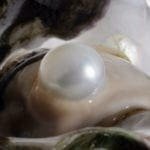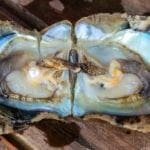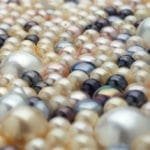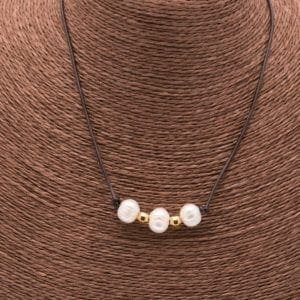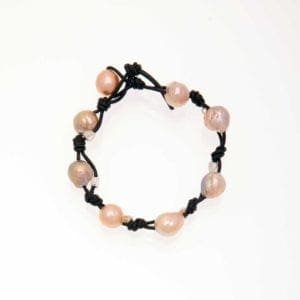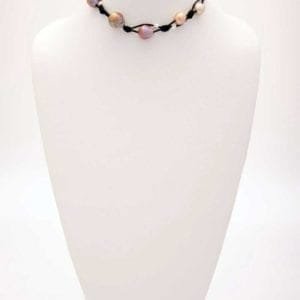What is Mother of Pearl?
Mother of pearl, also known as nacre, is an organic-inorganic composite material with a complex structure consisting of hexagonal platelets of aragonite, a form of calcium carbonate, arranged in very thin and parallel layers. Each layer is separated by sheets of organic matrix made up of elastic biopolymers, including silk-like proteins. This structure is what gives nacre its surprisingly tough strength.
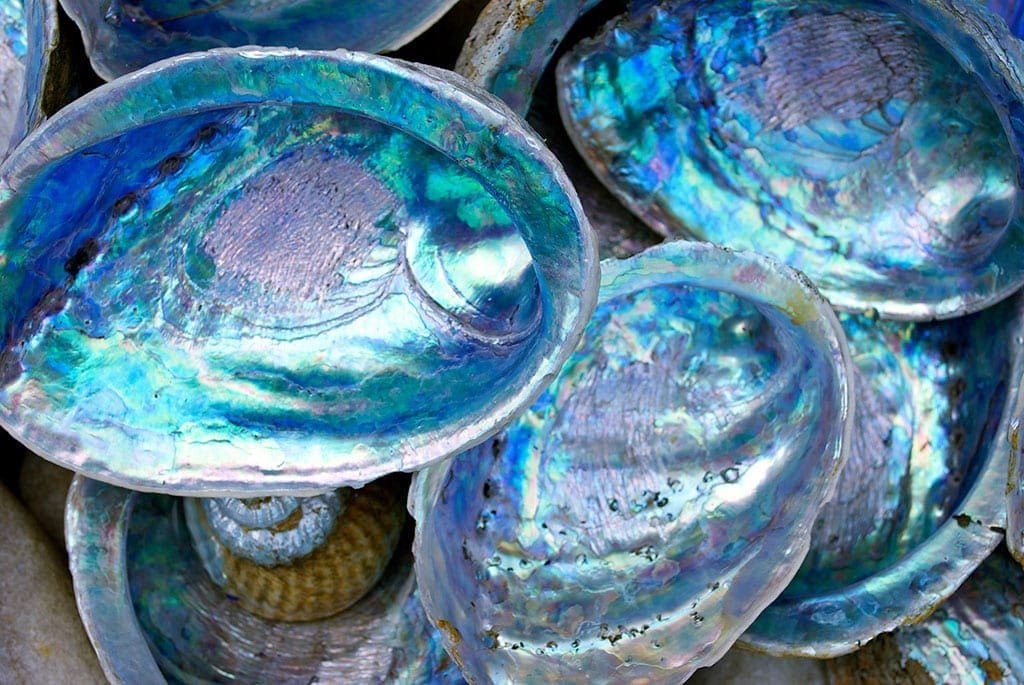
In nature, nacre serves a functional purpose. The layer of nacre that is formed by various mollusks serves to protect the softer tissues underneath from parasites and other damaging substances. Mollusks produce successive layers of nacre, a process known as encystation (the process of becoming a cyst). Nacre can be found in different types of mollusks such as pearl oysters, freshwater pearl mussels, and other mollusk families like the Trochidae and the Haliotidae, commonly known as abalone. It is most commonly found on the inner shell layer of these living organisms, as well as the outer coating of pearls.
One of the reasons people are attracted to mother of pearl is because it is iridescent, meaning that the colors appear to change as the object is moved in the light. This characteristic is also due to its composition. Because of its durability, natural beauty, and colors, mother of pearl is used for decorative, fashion, and architectural purposes.
Nacre is naturally produced by sea creatures, though scientists have recently been able to make a synthetic version.
Symbolism, Myths, and Meaning of Pearls
Throughout history, pearls became known for more than just another piece of beautiful, iridescent bit of jewelry. Egyptians used them in their mosaic artwork, Hindu legend has the god Krishna discovering pearls which he gave to his daughter, Pandaia, on her wedding day and in Egypt pearls were used as far back as 4200 B.C. Even Jackie Kennedy and Audrey Hepburn made a strand of pearls a ‘must-have’ fashion staple in every modern woman’s wardrobe. In the ancient world, natural pearls were so scarce only the rich and noble could afford them. The height of pearl mania reached its zenith in the Roman Empire when general Vitellius paid for a huge military campaign with his mother’s strand of pearls.
All historians agree that while the pearl was highly valued and revered throughout the ancient world, no one can name precisely who or exactly when the first pearl was discovered.
Where Do Natural, Wild Pearls Come From?
Unlike emeralds, rubies or diamonds, the pearl is the only gemstone with organic origins. Any mollusk, this includes clams, mussels, abalones and scallops, can produce a pearl. The single requirement is that the mollusks have a shell; however, not all mollusks produce that perfect spherical shape and shine we’ve all come to love. Composed of calcium carbonate, other pearl shapes include baroque, which is elongated, irregular, lumpy or curved. From ancient times until the time of Christopher Columbus pearls came from Ceylon, which is now Sri Lanka, the Persian Gulf, the rivers and lakes of China and Europe. Columbus’s third and fourth voyages to what is known today as Venezuela and Panama increased the demand for lustrous, natural pearls in Spain and Italy, but within a hundred years their scarcity was evident.
What Do Pearls Symbolize?
Throughout the centuries, the pearl became more than just a symbol of wealth. Because of its scarcity it soon became known as a symbol of purity, honesty and chastity. Authors John Steinbeck and Nathaniel Hawthorne use the word ‘pearl‘ to symbolize these very characteristics.
Hawthorne’s Hester Prynne in The Scarlet Letter names her daughter Pearl, a direct biblical reference to the Parable of the Pearl. If you haven’t read the novel, Hester becomes an outcast, because she conceives a child out of wedlock with Pastor Dimmesdale. Refusing to admit he committed adultery, Hester suffers humiliation, a bad reputation and loses her place in the community to live as an outcast. Her daughter, Pearl, then becomes known as the ‘pearl of great price.’ Upon his deathbed, Dimmesdale admits that he is Pearl’s father and seeks forgiveness from God as well as Pearl. At the end of the novel, Pearl is finally released from her reputation as the symbol of sin and can embrace her life as a ‘woman.’
You may remember reading The Pearl by John Steinbeck in junior high or high school. It’s based on Mexican folklore about a pearl diver which Steinbeck learns of during his visit to the La Paz, Baja California Sur region of Mexico. In the story, which Steinbeck refers to as a parable, a pearl diver Kino finds a pearl of great worth, but as the story progresses the pearl becomes a symbol of man’s greedy impulse, the precariousness in the meaning of the word ‘value,’ and the powerlessness to rise above one’s station in life.
Cleopatra’s Pearls
Cleopatra was said to drink a crushed pearl at a dinner party for Marc Anthony. Like most bad ideas; why does it always starts with a wager? Cleopatra and Marc Anthony made a bet that she could prove that Egypt was far superior and wealthier than Rome, therefore; not worthy of a conquest by giving THE most expensive dinner party in history. In front of guests, Cleopatra dissolved one pearl of a pair of earrings in a goblet filled with vinegar which she drank and then presented the other pearl to Marc Anthony. He declined and declared her the victor. Those two pearls were estimated to be worth $9.3 million, in current value, according to Pliny’s, the first recorded gemologist, in his book Natural History.
Pearls as Medicine
Pearls were given as medicine to cure insanity and some other ailments. Apparently, Cleopatra was onto something when she drank crushed pearls. Historical references are made to administering crushed pearls with water to Charles VI of France to cure his insanity. Francis Bacon, an English philosopher and Lord Chancellor of England, indicated in his works that pulverized pearls can prolong one’s life. In the early 19th century, some physicians of India believed the powder worked as a tonic and aphrodisiac. Historic prescriptions indicate pearls were also used as an ingredient to cure consumption, impotence and heart disease.
Crushed Pearl Powder
In 15th and 16th century England, royals toasted grand events with pulverized pearls in their wine. In Shakespeare’s time, it was common to pay tribute to royals with crushed pearl powder. At the knighthood of Sir Thomas Gresham by Queen Elizabeth, a pearl valued at 15,000 pounds was crushed and drunk by the newly-anointed knight and the Queen. For more proof, Shakespeare’s King Claudius refers to the practice of powdered pearl in wine when making a toast or tribute in the play Hamlet.
Pearl Colors
Hindus claimed specific pearl colors held certain virtues. For instance, a yellow shade to a pearl indicates wealth, a shade of honey color meant understanding, blue was for good luck, and white pearls gave you fame. On the flip side, damaged pearls could cause insanity, disgrace, death, leprosy, and loss of fortunes.
Where Do the Most Valuable Pearls Come From?
Which seas produce the most valuable pearls? The South Seas off the northern coast of Australia between Broome and Darwin holds the south sea pearl or sliver-lipped oysters that produce the most valuable pearl on Earth. It can grow up to 1 foot long and live up to 40 years. Because of its longevity, the harvested pearls are the most lustrous and largest in the entire world. Recently one south sea pearl was sold for over 1.5 million dollars.
Freshwater Pearls
At one time the United States was the largest producer of freshwater pearls. Many of these freshwater pearls are part of Europe’s royal collections and can be seen displayed in museums all over the globe. Another byproduct of American freshwater oysters or river oysters is mother-of-pearl buttons. Iowa became the hub for mother-of-pearl button manufacturing and shipped billions of these clasps until World War II. However, freshwater pearls began to diminish in the river beds during the mid-1800s because of over-harvesting and pollution as industrialization took off.


